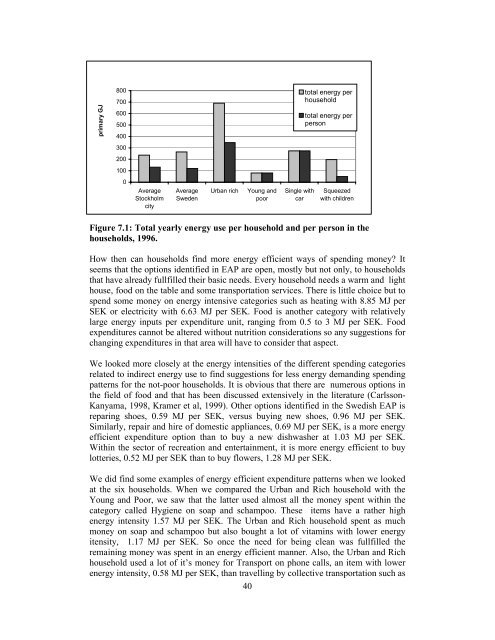Household Metabolism in the Five Cities.
Household Metabolism in the Five Cities.
Household Metabolism in the Five Cities.
You also want an ePaper? Increase the reach of your titles
YUMPU automatically turns print PDFs into web optimized ePapers that Google loves.
primary GJ<br />
800<br />
700<br />
600<br />
500<br />
400<br />
total energy per<br />
household<br />
total energy per<br />
person<br />
300<br />
200<br />
100<br />
0<br />
Average<br />
Stockholm<br />
city<br />
Average<br />
Sweden<br />
Urban rich<br />
Young and<br />
poor<br />
S<strong>in</strong>gle with<br />
car<br />
Squeezed<br />
with children<br />
Figure 7.1: Total yearly energy use per household and per person <strong>in</strong> <strong>the</strong><br />
households, 1996.<br />
How <strong>the</strong>n can households f<strong>in</strong>d more energy efficient ways of spend<strong>in</strong>g money? It<br />
seems that <strong>the</strong> options identified <strong>in</strong> EAP are open, mostly but not only, to households<br />
that have already fullfilled <strong>the</strong>ir basic needs. Every household needs a warm and light<br />
house, food on <strong>the</strong> table and some transportation services. There is little choice but to<br />
spend some money on energy <strong>in</strong>tensive categories such as heat<strong>in</strong>g with 8.85 MJ per<br />
SEK or electricity with 6.63 MJ per SEK. Food is ano<strong>the</strong>r category with relatively<br />
large energy <strong>in</strong>puts per expenditure unit, rang<strong>in</strong>g from 0.5 to 3 MJ per SEK. Food<br />
expenditures cannot be altered without nutrition considerations so any suggestions for<br />
chang<strong>in</strong>g expenditures <strong>in</strong> that area will have to consider that aspect.<br />
We looked more closely at <strong>the</strong> energy <strong>in</strong>tensities of <strong>the</strong> different spend<strong>in</strong>g categories<br />
related to <strong>in</strong>direct energy use to f<strong>in</strong>d suggestions for less energy demand<strong>in</strong>g spend<strong>in</strong>g<br />
patterns for <strong>the</strong> not-poor households. It is obvious that <strong>the</strong>re are numerous options <strong>in</strong><br />
<strong>the</strong> field of food and that has been discussed extensively <strong>in</strong> <strong>the</strong> literature (Carlsson-<br />
Kanyama, 1998, Kramer et al, 1999). O<strong>the</strong>r options identified <strong>in</strong> <strong>the</strong> Swedish EAP is<br />
repar<strong>in</strong>g shoes, 0.59 MJ per SEK, versus buy<strong>in</strong>g new shoes, 0.96 MJ per SEK.<br />
Similarly, repair and hire of domestic appliances, 0.69 MJ per SEK, is a more energy<br />
efficient expenditure option than to buy a new dishwasher at 1.03 MJ per SEK.<br />
With<strong>in</strong> <strong>the</strong> sector of recreation and enterta<strong>in</strong>ment, it is more energy efficient to buy<br />
lotteries, 0.52 MJ per SEK than to buy flowers, 1.28 MJ per SEK.<br />
We did f<strong>in</strong>d some examples of energy efficient expenditure patterns when we looked<br />
at <strong>the</strong> six households. When we compared <strong>the</strong> Urban and Rich household with <strong>the</strong><br />
Young and Poor, we saw that <strong>the</strong> latter used almost all <strong>the</strong> money spent with<strong>in</strong> <strong>the</strong><br />
category called Hygiene on soap and schampoo. These items have a ra<strong>the</strong>r high<br />
energy <strong>in</strong>tensity 1.57 MJ per SEK. The Urban and Rich household spent as much<br />
money on soap and schampoo but also bought a lot of vitam<strong>in</strong>s with lower energy<br />
itensity, 1.17 MJ per SEK. So once <strong>the</strong> need for be<strong>in</strong>g clean was fullfilled <strong>the</strong><br />
rema<strong>in</strong><strong>in</strong>g money was spent <strong>in</strong> an energy efficient manner. Also, <strong>the</strong> Urban and Rich<br />
household used a lot of it’s money for Transport on phone calls, an item with lower<br />
energy <strong>in</strong>tensity, 0.58 MJ per SEK, than travell<strong>in</strong>g by collective transportation such as<br />
40
















